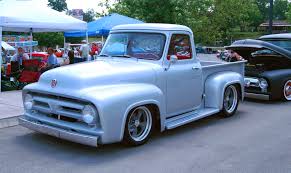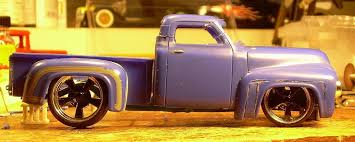-
Posts
38,188 -
Joined
-
Last visited
Content Type
Profiles
Forums
Events
Gallery
Everything posted by Ace-Garageguy
-
The "flat" effect you're getting could possibly be due to high humidity (blushing), or the object you're painting being colder than your paint (which causes moisture condensation on the paint surface, also resulting in blushing). Try rubbing your face with a fingertip (to get just a little skin oil on it), and then seeing if you can polish-out the "flatness" in a very small area with the same fingertip. If the shine comes up, that's a good indication you're dealing with blushing. A clear coat will alleviate the problem, but if the clear blushes, you may still have to do some light polishing. IF you're getting blushing, the best solution is to try to do your painting when the temps are between 65 and 80F, and the humidity is below 65%. And rather than sanding the areas on wheels you want to paint, I'd suggest carefully masking the area you don't want painted, and vigorously scrubbing the to-be-painted area with Comet, or another aggressive abrasive-type cleaner and a stiff brush. You'll have an easier time getting into all the small crevices that are impossible to reach with sandpaper. For wheels especially, I'd recommend a "self etching" primer as well. Duplicolor makes one, and it should give you a little better adhesion. It would be great if you can get a piece of material similar to what your wheels are made from, or a junk alloy wheel, to practice on before you shoot the real thing. Different substrates can affect how a color coat behaves. For instance, you can often paint a plastic real-car bumper at the same time, on the same day, with the same paint, over the same primer, as you paint the fender adjacent to it...and you'll get a slightly different color, because the flakes lay down a little differently. Likewise, painting an alloy wheel, your paint may behave differently than it does painting a model-car body.
-

Autoquiz 393 - Finished
Ace-Garageguy replied to carsntrucks4you's topic in Real or Model? / Auto ID Quiz
I've seen those little guys before somewhere. -
Wow. And I always thought it meant someone who actually knows what he's talking about, rather than somebody who just thinks he does.
-

car you always dreamed of owning but always just out of reach
Ace-Garageguy replied to youpey's topic in The Off-Topic Lounge
Positive attitude, man, positive attitude. Love the S10 with cats, by the way. She's in about the same shape as my daily driver...including the cats. Only question is how you get rust holes in Arizona? -
It pretty much HAS to be shot wet to get a nice gloss with minimal o'peel...but if it's "wrinkling", the only things that should cause that are 1) incompatibility with your primer (most likely cause), or 2) extreme crazing of the increasingly soft plastics in today's kits. I love Duplicolor because for me, it's almost always a guaranteed good finish...but you HAVE to shoot it over a solvent-resistant primer, like the companion Duplicolor products. This is Duplicolor rattlecan shot wet over Duplicolor's primer. No sanding or buffing yet in this shot...
-

41 Willys rat rod wrecker
Ace-Garageguy replied to mchook's topic in Model Trucks: Pickups, Vans, SUVs, Light Commercial
Great idea using the long bed and longer chassis to get a wrecker from the Willys cab. Pretty cool all the way around. -

AMT 1934 Ford Truck Custom
Ace-Garageguy replied to mvadrag's topic in Model Trucks: Pickups, Vans, SUVs, Light Commercial
I like it. A LOT. Has a great period feel with all those vintage parts, looks like something built in the '60s. Very nice. -

Math for modelers
Ace-Garageguy replied to Richard Bartrop's topic in Links to Aftermarket Suppliers
Some good stuff there all in one place, but this one is really special... Conversion of pounds into inches https://planetcalc.com/348/ -

stait front axle assembly, aftermarket?
Ace-Garageguy replied to fiatboy's topic in Car Aftermarket / Resin / 3D Printed
Straight axles are pretty easy to do in scale if you want to try your hand at scratch-building...and cost almost nothing in materials. All you need is some styrene or brass tube or rod stock for the axle and ends, some strip or sheet styrene or brass for the springs, and some channel for spindles. The photo below shows a leaf-spring made from .020" styrene strip stock, with rod-stock ends. The axle is in the process of being made up from rod or tube. The next shot shows a more-or-less complete axle assembly, with spindles made from channel (in this case, cut from square stock), and stub-axles made from smaller rod stock. Kingpins are made from .040 wire in this case. This last shot shows brackets that the spring ends mount to, fabricated on the frame. -
GREAT word. One of my personal favorites. EDIT: Funny how much it has in common with characteristics attributed to the Dunning-Kruger effect.
-
Yup...though the generator-mounted pump is listed as being fitted through 1961 on some models. NOTE: This is probably the correct setup for 1960, as Eckler's sells the bracket set for 1960-1964, 348 and 409 engines. https://www.lategreatchevy.com/full-size-chevy-power-steering-pump-bracket-set-348-and-409ci-1960-1964.html
-
Here's one for tomorrow: NOTE: This is in no way political commentary. It is simply a word definition.
-
Stunning craftsmanship in a variety of materials, and impressive tenacity...as always. Beautiful work, sir. I had never noticed the swirly-doodles (that's a highly technical styling term) in the centers of the fenders do not in fact line up with the axle centerlines until I saw the reference photo directly above. Most interesting.
-
In the real world... The 350 ('58 only), 361, 383 and 400 are B motors, or low deck big blocks. They have the same outside dimensions and parts interchange. Water pumps, exhaust, intakes...all the sameThe 383 ('59 & '60), 413, 426 wedge, 440 are all RB motors, or tall deck big blocks. They have the taller deck height to accommodate the longer stroke. Therefore, they are slightly wider and the intakes on these motors do NOT interchange with the B motors. In the model world... Because the deck height difference on the real engines is only about 3/4", less than 1mm in 1/25 scale, it won't be obvious, and scaling discrepancies from kit manufacturer to kit manufacturer will likely be greater than the difference in the real engines (if scaled absolutely correctly). So, with a little work (depending on which B or RB engine your kit represents, everything should fit everything.
-

Who is this resin seller? Any info?
Ace-Garageguy replied to Ace-Garageguy's topic in Car Aftermarket / Resin / 3D Printed
Based on the thread Casey posted, I'll pass on all of it. I've 'bout had my lifetime fill of correcting other people's work. -

car you always dreamed of owning but always just out of reach
Ace-Garageguy replied to youpey's topic in The Off-Topic Lounge
Yup. -

Does This Song Remind You of Anything?
Ace-Garageguy replied to Snake45's topic in The Off-Topic Lounge
Gots a lil symfony fo de debil goin on... -

car you always dreamed of owning but always just out of reach
Ace-Garageguy replied to youpey's topic in The Off-Topic Lounge
In the late 1980s, I owned both a restoration shop and a fleet-vehicle services company. I was doing pretty well financially, and made a deposit on a Safir GT40 continuation car (the originals were already out of my price range, but the Safir cars, Ford-approved REAL GT40s, were still accessible). http://www.silverstoneauctions.com/1989-safir-gt40-mark-v-powered-by-ford I had a block of Eastern Airlines stock that I'd intended to liquidate to pay off the Safir when the time came, but it started to tank, and I held on to the bitter end as Eastern finally went down in flames, crashing into bankruptcy, and taking my nest-egg with it. So ended the GT40 dream. -
Yes sir. I'm making a bunch of small parts for a custom instrument panel I'm building for a real DeLorean, and for models, I've been able to turn some aluminum wheel sleeves that fit turned-down centers of plastic kit wheels...and turning plastic kit rims to fit aftermarket centers (like the PE wire centers made for aircraft models that will work as cycle wheels for dragsters). Had to get a slow-speed setup to be able to turn plastic parts (so they don't melt), and the company that sold me that also makes repop drive belts in modern materials. Most of the original belts are hard and dry by now (40 to 50+ years old), but there are enough people using these machines that lotsa parts are available, some newly manufactured. There's a lot of NOS stuff floating around too. The little tool will do just about everything my big mill and lathe will do, just on a vastly reduced scale.
- 38,661 replies
-
- johan
- glue bombs
-
(and 1 more)
Tagged with:
-
More tooling and accessories for the Unimat...
- 38,661 replies
-
- johan
- glue bombs
-
(and 1 more)
Tagged with:
-
I really used to love the fact that Sears stocked parts for out-of-production stuff, sometimes for decades..but with the advent of a more throwaway attitude towards consumer items in general, and a cheapening of products in general (and offshore sourcing), and a change-for-the-sake-of-change marketing ethic intended to encourage throwing stuff out rather than fixing it, they shut down their huge parts warehouse here many years ago.
-
Yeah, that would be the "part of the roofline" I referred to as one few things GM did use from that particular exercise...though I now see I should have been very specific. I thought it was so obvious I didn't need to really go into it, but it would have made more sense if I'd said "greenhouse" rather than "roofline" anyway.


